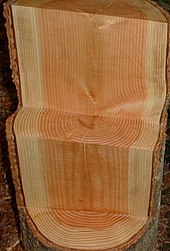Growth ring
As growth rings is referred to in the biology in plants or animals visible rings, caused by periodic growth.
Typical causes for growth rings are the different growth due to temperature differences in the course of the year (cold winters with dormant vegetation and summer as the growth period) or the contrast between rainy seasons and dry seasons with abundant or poor food supply, for example for turtles . In the ocean, the tides can also lead to daily growth rings.
Occurrence
The best known are the annual rings of trees in temperate zones. In addition to trees, perennial herbs such as the genus Nolana also develop growth rings. Animal growth rings occur in the segments of turtle shells (e.g. the forest brook turtle and the spurred tortoise ) and in some dinosaur bones (e.g. from Patagopteryx , Gigantoraptor or Orodromeus ). In box jellyfish , fine lines can be found on the statoliths in the statocysts , which are interpreted as daily growth rings. Growth rings can also be found on the scales of some fish, such as the elasmoid scales of bony fish ; also on the tusks of woolly mammoths .
Using Daily Growth Rings for Science
For prehistoric times, the speed of the earth's rotation can be read off daily growth rings of fossil marine organisms with calcareous skeletons. If the daily increase is modulated by the monthly change of nippy and spring tide or by the annual change of seasons (as can also be observed in relatives of such organisms living today), then the number of days in the month can at least in principle be determined by counting the rings or determine in the year.
Individual evidence
- ^ G. Pannella: Paleontological Evidence on the Earth's Rotational History since Early Precambrian . Astrophysics and Space Science, Vol 16, 1972, pp 212-237. bibcode : 1972Ap & SS..16..212P

